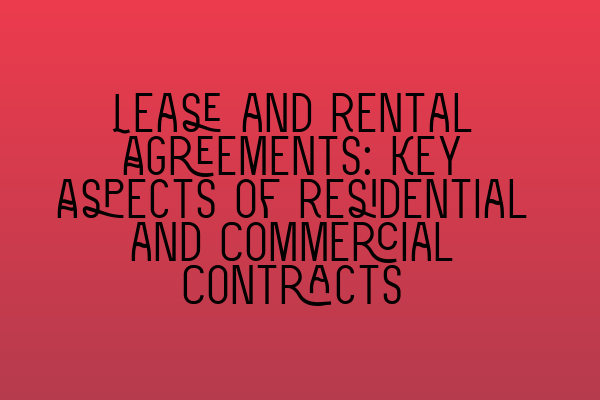Lease and Rental Agreements: Key Aspects of Residential and Commercial Contracts
If you’re considering leasing or renting a residential or commercial property, it’s crucial to have a clear understanding of the key aspects of lease and rental agreements. These agreements outline the rights and responsibilities of both landlords and tenants, ensuring a harmonious and legally sound relationship throughout the duration of the lease or rental period.
In this comprehensive guide, we will explore the essential elements of lease and rental agreements, providing you with valuable insights and information to navigate these contracts with confidence. Let’s dive in!
1. Understanding the Basics of Lease and Rental Agreements
Before we delve into the specifics, let’s start by understanding the fundamental features of lease and rental agreements. These documents serve as legal contracts between landlords and tenants, governing the terms under which a property is leased or rented.
A lease agreement typically covers longer-term rentals, such as residential properties, and usually lasts for a year or more. On the other hand, a rental agreement often refers to shorter-term rentals, such as vacation homes or commercial spaces, which may span a few weeks to a few months.
2. Essential Terms and Conditions
Every lease and rental agreement should include certain key terms and conditions to protect the rights of both parties involved. Here are some key aspects to look out for:
a) Rental Amount and Payment Terms: Clearly state the amount of rent, the frequency of payment, and the acceptable modes of payment. It’s important to specify any late payment fees or penalties to avoid potential disputes.
b) Duration of the Lease or Rental Period: Clearly define the start and end dates of the lease or rental period. In the case of a lease agreement, mention whether it will automatically renew or require the parties to renegotiate the terms upon expiration.
c) Security Deposit: Detail the amount of the security deposit required, its purpose, and the conditions under which it will be returned to the tenant.
d) Maintenance and Repairs: Specify the responsibilities of both the landlord and the tenant regarding property maintenance and repairs. It’s vital to clarify who is responsible for routine maintenance, such as lawn care or appliance repairs, and who is responsible for major structural repairs.
3. Rights and Obligations of Landlords
As a landlord, it is essential to understand your rights and obligations under lease and rental agreements. These agreements should clearly outline the landlord’s responsibilities, such as:
a) Providing a Safe and Habitable Property: Landlords have a legal duty to ensure that the property meets all health and safety requirements and is habitable for tenants.
b) Property Maintenance: Landlords are typically responsible for major repairs and structural maintenance, as well as providing essential utilities such as water, heating, and electricity.
c) Privacy Rights: It’s crucial to inform tenants about their rights to privacy and obtain appropriate consent before entering the rental property for inspections or repairs.
4. Rights and Obligations of Tenants
Tenants also have specific rights and obligations when entering into a lease or rental agreement. As a tenant, it’s important to understand these rights and responsibilities, including:
a) Paying Rent on Time: Tenants must pay rent on time according to the agreed-upon terms, ensuring that no late payment fees are incurred.
b) Property Care and Maintenance: Tenants are generally responsible for routine maintenance, cleanliness, and ensuring the property remains in good condition throughout the tenancy.
c) Right to Quiet Enjoyment: Tenants have the right to peacefully and freely enjoy their rental property without unnecessary interference from the landlord.
5. Lease and Rental Termination
Lease and rental agreements should include provisions for termination or early termination. These provisions outline the conditions and processes involved when either the landlord or the tenant wishes to end the lease or rental agreement before its natural expiration.
It’s crucial to fully understand the termination clauses and any associated penalties or notice periods to avoid potential misunderstandings or legal complications.
Conclusion
Lease and rental agreements play a vital role in establishing clear expectations and protecting the rights of both landlords and tenants. Understanding the key aspects of these contracts is essential for a successful and harmonious landlord-tenant relationship.
If you’re in the process of leasing or renting a property, it’s important to seek legal advice to ensure that your rights and interests are protected. At SQE Contract Law, we offer expert guidance and support throughout the entire contract process, ensuring that you enter into agreements that are fair, enforceable, and tailored to your specific needs.
For further information on legal topics related to contract law, feel free to explore our related articles:
– Mentorship for Aspiring Solicitors: Nurturing Talent in the Legal Field
– Legal Challenges and Pitfalls: Navigating the Complexities of the Legal System
– The GDL (Graduate Diploma in Law): A Pathway to Becoming a Solicitor
– Mastering the Solicitor’s Path: Prepare for the Journey Ahead
– The Benefits of Becoming a Solicitor: A Rewarding Career
Remember, having a well-drafted lease or rental agreement is a crucial step in protecting your interests and ensuring a successful tenancy. Let SQE Contract Law guide you through the process and provide you with the expertise you need. Contact us today for a consultation!
